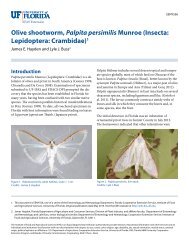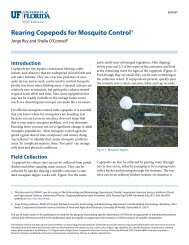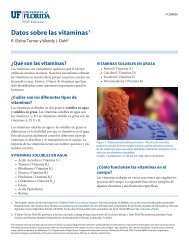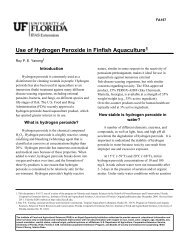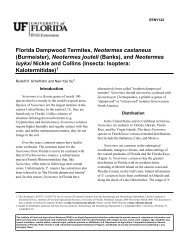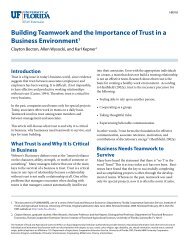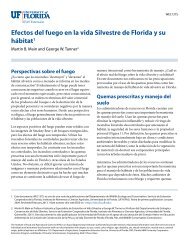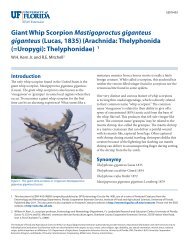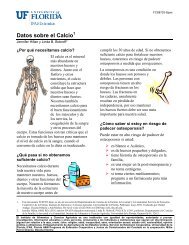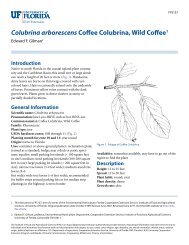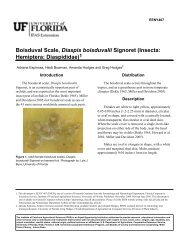Mediterranean Fruit Fly, Ceratitis capitata (Wiedemann) - EDIS ...
Mediterranean Fruit Fly, Ceratitis capitata (Wiedemann) - EDIS ...
Mediterranean Fruit Fly, Ceratitis capitata (Wiedemann) - EDIS ...
Create successful ePaper yourself
Turn your PDF publications into a flip-book with our unique Google optimized e-Paper software.
EENY-214<br />
<strong>Mediterranean</strong> <strong>Fruit</strong> <strong>Fly</strong>, <strong>Ceratitis</strong> <strong>capitata</strong> (<strong>Wiedemann</strong>)<br />
(Insecta: Diptera: Tephritidae) 1<br />
M. C. Thomas, J. B. Heppner, R. E. Woodruff, H. V. Weems, G. J. Steck and T. R. Fasulo 2<br />
Introduction<br />
The <strong>Mediterranean</strong> fruit fly, <strong>Ceratitis</strong> <strong>capitata</strong><br />
(<strong>Wiedemann</strong>), is one of the world's most destructive<br />
fruit pests. The species originated in sub-Saharan<br />
Africa and is not known to be established in the<br />
continental United States. When it has been detected<br />
in Florida, California and Texas, especially in recent<br />
years, each infestation necessitated intensive and<br />
massive eradication and detection procedures so that<br />
the pest did not become established.<br />
Figure 1. Adult male <strong>Mediterranean</strong> fruit fly, <strong>Ceratitis</strong><br />
<strong>capitata</strong> (<strong>Wiedemann</strong>). Photograph by: USDA<br />
Because of its wide distribution over the world,<br />
its ability to tolerate cooler climates better than most<br />
other species of tropical fruit flies, and its wide range<br />
of hosts, it is ranked first among economically<br />
important fruit fly species. Its larvae feed and develop<br />
on many deciduous, subtropical, and tropical fruits<br />
and some vegetables. Although it may be a major pest<br />
of citrus, often it is a more serious pest of some<br />
deciduous fruits, such as peach, pear, and apple. The<br />
larvae feed upon the pulp of host fruits, sometimes<br />
tunneling through it and eventually reducing the<br />
whole to a juicy, inedible mass. In some of the<br />
<strong>Mediterranean</strong> countries, only the earlier varieties of<br />
citrus are grown, because the flies develop so rapidly<br />
that late season fruits are too heavily infested to be<br />
marketable. Some areas have had almost 100%<br />
infestation in stone fruits. Harvesting before complete<br />
maturity also is practiced in <strong>Mediterranean</strong> areas<br />
generally infested with this fruit fly.<br />
In this age of jet transportation, the "medfly" can<br />
be transported from one part of the world to some<br />
distant place in a matter of hours, which greatly<br />
complicates efforts to contain it within its present<br />
distribution. Once it is established, eradication efforts<br />
1. This document is EENY-214 (IN371) (originally published as DPI Entomology Circulars 4, 230 and 273, updated for this publication), one of a series of<br />
Featured Creatures from the Entomology and Nematology Department, Florida Cooperative Extension Service, Institute of Food and Agricultural<br />
Sciences, University of Florida. Published: July 2001. Revised: June 2010 and September 2010. This document is also available on Featured Creatures Web<br />
site at http://entomology.ifas.ufl.edu/creatures. Please visit the <strong>EDIS</strong> Web site at http://edis.ifas.ufl.edu.<br />
2. M. C. Thomas, J. B. Heppner, R. E. Woodruff, H. V. Weems, G. J. Steck, Florida Department of Agriculture and Consumer Services, Division of Plant<br />
Industry; and T. R. Fasulo, Entomology and Nematology Department, University of Florida, Gainesville, FL.<br />
The Institute of Food and Agricultural Sciences (IFAS) is an Equal Opportunity Institution authorized to provide research, educational information and<br />
other services only to individuals and institutions that function with non-discrimination with respect to race, creed, color, religion, age, disability, sex,<br />
sexual orientation, marital status, national origin, political opinions or affiliations. U.S. Department of Agriculture, Cooperative Extension Service,<br />
University of Florida, IFAS, Florida A. & M. University Cooperative Extension Program, and Boards of County Commissioners Cooperating. Millie<br />
Ferrer-Chancy, Interim Dean
<strong>Mediterranean</strong> <strong>Fruit</strong> <strong>Fly</strong>, <strong>Ceratitis</strong> <strong>capitata</strong> (<strong>Wiedemann</strong>) (Insecta: Diptera: Tephritidae) 2<br />
may be extremely difficult and expensive. In addition<br />
to reduction of crop yield, infested areas have the<br />
additional expense of control measures and costly<br />
sorting processes for both fresh and processed fruit<br />
and vegetables. Some countries maintain quarantines<br />
against the medfly, which could jeopardize some<br />
fresh fruit markets if it should become established in<br />
Florida.<br />
Synonymy<br />
<strong>Ceratitis</strong> citriperda MacLeay<br />
<strong>Ceratitis</strong> hispanica De Brême<br />
Paradalaspis asparagi Bezzi<br />
Tephritis <strong>capitata</strong> <strong>Wiedemann</strong><br />
<strong>Ceratitis</strong> <strong>capitata</strong> (<strong>Wiedemann</strong>)<br />
Distribution<br />
Countries with established infestations include<br />
(CABI 1999):<br />
• Africa: Algeria, Angola, Berin, Botswana,<br />
Burkina Faso, Burundi, Cameroon, Cape<br />
Verde, Congo, Congo Democratic Republic,<br />
Cote d'Ivoire, Egypt, Ethiopia, Gabon,<br />
Ghana, Guinea, Kenya, Liberia, Libya,<br />
Madagascar, Malwai, Mali, Maritius,<br />
Morocco, Mozambique, Niger, Nigeria,<br />
Reunion, Sao Tome & Principe, Senegal,<br />
Seychelles, Sierra Leone, South Africa, St.<br />
Helena, Sudan, Tanzania, Togo, Tunisia,<br />
Uganda, Zimbabwe<br />
• Asia: Cyprus, Israel, Jordan, Lebanon,<br />
Saudi Arabia, Syria, Turkey, Yemen<br />
• Australia: Western Australia<br />
• Central American and Caribbean: Costa<br />
Rica, El Salvador, Guatemala, Honduras,<br />
Jamaica, Netherlands Antilles, Nicaragua,<br />
Panama, Puerto Rico<br />
• Europe: Albania, Azores, Balearic Islands,<br />
Canary Islands, Corsica, Croatia, France,<br />
Greece, Italy, Maderia Islands, Portugal,<br />
southern Russia, Sardinia, Sicily, Slovenia,<br />
Spain, Yugoslavia<br />
• South American: Argentina, Brazil,<br />
Colombia, Ecuador, Paraguay, Peru,<br />
Uruguay, Venezuela<br />
<strong>Mediterranean</strong> fruit fly infestations in the United<br />
States occurred in:<br />
• Hawaii since 1907 (Mau et al. 2007), and<br />
became established by 1910;<br />
• Florida from April 1929 to July 1930, April<br />
1956 to November 1957, June 1962 to<br />
February 1963, June to August 1963, 3-14<br />
August 1981, and April to August 1998;<br />
with one or two flies found in various<br />
counties during 1967, 1983 to 1988, 1990 to<br />
1991 and in May to October, 1997. During<br />
June–August 2010, the largest outbreak<br />
since the 1997-1998 infestations was<br />
discovered and eradicated in Palm Beach<br />
County in the Boca Raton area (FDACS<br />
2010a, 2010c);<br />
• Texas during June and July 1966;<br />
• California in 1975, and periodically since<br />
1980. Reinfestations in the same areas lead<br />
some experts to believe the California<br />
infestation was never eradicated but was<br />
instead reduced to subdetectable levels that<br />
periodically resurface (Dawson et al. 1998,<br />
Papadopoulos 2008).<br />
Identification<br />
The medfly has no near relatives in the Western<br />
Hemisphere. The adults are slightly smaller than a<br />
house fly and have picture wings typical of fruit flies.<br />
They can be distinguished fairly readily from any of<br />
the native fruit flies of the New World.<br />
Egg: The egg is very slender, curved, 1 mm long,<br />
smooth and shiny white. The micropylar region is<br />
distinctly tubercular.<br />
Larva: Larva are white with a typical fruit fly<br />
larval shape, i.e. cylindrical maggot-shape, elongate,<br />
anterior end narrowed and somewhat recurved<br />
ventrally, with anterior mouth hooks, and flattened<br />
caudal end. The last instar is usually 7 to 9 mm in<br />
length, with eight ventral fusiform areas. The anterior
<strong>Mediterranean</strong> <strong>Fruit</strong> <strong>Fly</strong>, <strong>Ceratitis</strong> <strong>capitata</strong> (<strong>Wiedemann</strong>) (Insecta: Diptera: Tephritidae) 3<br />
Figure 2. Incidence of the <strong>Mediterranean</strong> fruit fly, <strong>Ceratitis</strong><br />
<strong>capitata</strong> (<strong>Wiedemann</strong>), in Florida, 1929-1998. Drawing<br />
by: G.J. Steck and B.D. Sutton, Division of Plant Industry.<br />
Figure 3. Eggs of the <strong>Mediterranean</strong> fruit fly, <strong>Ceratitis</strong><br />
<strong>capitata</strong> (<strong>Wiedemann</strong>). Photograph by: Jeffery Lotz,<br />
Florida Department of Agriculture and Consumer<br />
Services-Division of Plant Industry;<br />
www.forestryimages.org<br />
buccal carinae are usually nine to 10 in number. The<br />
anterior spiracles are usually nearly straight on dorsal<br />
edge of tubule row (often more straight than<br />
illustrated). There are usually nine to 10 tubules,<br />
although there may be seven to 11.<br />
The cephalo-pharyngeal skeleton has a large<br />
convex mouth hook each side, approximately 2X<br />
hypostome in length. The hypostomium has<br />
prominent, rounded subhypostomium;<br />
post-hypostomial plates curved dorsally to the dorsal<br />
bridge, fused with sclerotized rays of central area of<br />
dorsal wing plate. The parastomium is prominent. The<br />
Figure 4. Larva of the <strong>Mediterranean</strong> fruit fly, <strong>Ceratitis</strong><br />
<strong>capitata</strong> (<strong>Wiedemann</strong>). Head is to the left. Photograph<br />
by: Jeffery Lotz, Florida Department of Agriculture and<br />
Consumer Services-Division of Plant Industry;<br />
www.forestryimages.org<br />
Figure 5. Lateral view of a mature larva of the<br />
<strong>Mediterranean</strong> fruit fly, <strong>Ceratitis</strong> <strong>capitata</strong> (<strong>Wiedemann</strong>).<br />
Head is to the right. Graphic by: Division of Plant<br />
Industry<br />
Figure 6. Head and buccal carinae of larva of the<br />
<strong>Mediterranean</strong> fruit fly, <strong>Ceratitis</strong> <strong>capitata</strong> (<strong>Wiedemann</strong>).<br />
Graphic by: Division of Plant Industry<br />
Figure 7. anterior spiracles of larva Credits:
<strong>Mediterranean</strong> <strong>Fruit</strong> <strong>Fly</strong>, <strong>Ceratitis</strong> <strong>capitata</strong> (<strong>Wiedemann</strong>) (Insecta: Diptera: Tephritidae) 4<br />
anterior of the dorsal bridge has a prominent<br />
sclerotized point. The dorsal wing plate is nearly as<br />
long as the pharyngeal plate. The median area is<br />
relatively unsclerotized. The pharyngeal plate is<br />
elongate, with prominent median hood and anterior<br />
sclerotized area.<br />
Figure 8. Larval cephalo-pharyngeal skeleton of the<br />
<strong>Mediterranean</strong> fruit fly, <strong>Ceratitis</strong> <strong>capitata</strong> (<strong>Wiedemann</strong>).<br />
Graphic by: Division of Plant Industry<br />
The caudal end has bifurcate or paired dorsal<br />
papillules (D1 and D2) on small mount of relatively<br />
flat plate; intermediate papillules (I1-2) as a line of<br />
fused elevations on a very enlarged subspiracular<br />
tubercle, plus a remote I3 at approximately 45 degrees<br />
from I1-2; L1 on the median edge of the caudal end;<br />
V1 not prominent; posterior spiracles elongate (4.5 to<br />
5X width), with dorsal and ventral spiracles angled<br />
away from relatively planar median spiracle;<br />
interspiracular processes (hairs) usually not branched;<br />
anal lobe bifid or entire.<br />
Figure 9. Caudal end of larva of the <strong>Mediterranean</strong> fruit<br />
fly, <strong>Ceratitis</strong> <strong>capitata</strong> (<strong>Wiedemann</strong>). Graphic by: Division<br />
of Plant Industry<br />
Larval Diagnosis: The primary diagnostic<br />
characters for <strong>Mediterranean</strong> fruit fly larvae involve<br />
Figure 10. Posterior spiracles (left side) (after Phillips<br />
1946) of a larva of the <strong>Mediterranean</strong> fruit fly, <strong>Ceratitis</strong><br />
<strong>capitata</strong> (<strong>Wiedemann</strong>). Graphic by: Division of Plant<br />
Industry<br />
Figure 11. anal lobes of larva<br />
the anterior spiracles, the buccal carinae, and the<br />
prominent subspiracular tubercles of the caudal end.<br />
The anterior spiracles have the tubule edge relatively<br />
straight dorsally and the tubule number usually is<br />
nine to 10, although it can be from seven to 11. The<br />
buccal carinae number is nine to 10. The caudal end<br />
has two prominent subspiracular tubercles, each with<br />
a crescent of irregularly fused papillules<br />
(approximately equivalent to I1-2). The anal lobe is<br />
either bifid or entire. The pharyngeal skeleton is<br />
distinctive in overall configuration, particularly the<br />
enlarged subhypostomium of the hypostomium<br />
(posterior to each mouth hook). There is a heavily
<strong>Mediterranean</strong> <strong>Fruit</strong> <strong>Fly</strong>, <strong>Ceratitis</strong> <strong>capitata</strong> (<strong>Wiedemann</strong>) (Insecta: Diptera: Tephritidae) 5<br />
sclerotized dorsal bridge point at the anterior of the<br />
dorsal wing plate. The shape of the interior<br />
sclerotizations of the dorsal wing plate and the hood<br />
of the pharyngeal plate are also distinctive for the<br />
species.<br />
The features of the larvae of C. <strong>capitata</strong>, as noted<br />
in the description, are variable to some degree as<br />
indicated. Most previous illustrations of the<br />
cephalo-pharyngeal skeleton of the species have not<br />
shown the pharyngeal plate hood, and details of the<br />
illustrations also vary among themselves (see Greene<br />
1929, Phillips 1946). The figure of the<br />
cephalo-pharyngeal skeleton in Greene (1929)<br />
appears not to be very accurate. The supposed<br />
supernumerary lateral papillules of the caudal end,<br />
noted by Phillips (1946), are not usually evident in<br />
specimens or at most represent only slight plate<br />
elevations on the very lateral edge dorsal to L1.<br />
Larvae examined came from verified samples<br />
from Florida, Hawaii, and Portugal (all are in the<br />
larval collection of the Museum of Entomology,<br />
Florida State Collection of Arthropods).<br />
Pupa: The pupa is cylindrical, 4 to 4.3 mm long,<br />
dark reddish brown, and resembles a swollen grain of<br />
wheat.<br />
Figure 12. Pupae of the <strong>Mediterranean</strong> fruit fly, <strong>Ceratitis</strong><br />
<strong>capitata</strong> (<strong>Wiedemann</strong>). Photograph by: Jeffery Lotz,<br />
Florida Department of Agriculture and Consumer<br />
Services-Division of Plant Industry; www.forestryimage.org<br />
Adult: The adult fly is 3.5 to 5 mm in length. The<br />
color is yellowish with brown tinge, especially on<br />
Figure 13. pupal views<br />
Figure 14. An adult <strong>Mediterranean</strong> fruit fly, <strong>Ceratitis</strong><br />
<strong>capitata</strong> (<strong>Wiedemann</strong>), emerging from a puparium. Head is<br />
to the left. Photograph by: Anne-Sophie Roy, European<br />
and <strong>Mediterranean</strong> Plant Protection Organization;<br />
www.forestryimages.org<br />
abdomen, legs, and some markings on wings. The<br />
lower corners of the face have white setae. Eyes are<br />
reddish purple (fluoresce green, turning blackish<br />
within 24 hours after death). Ocellar bristles are<br />
present. The male has a pair of bristles with enlarged<br />
spatulate tips next to the inner margins of the eyes.<br />
The thorax is creamy white to yellow with a<br />
characteristic pattern of black blotches. Light areas<br />
have very fine white bristles. Humeral bristles are<br />
present. Dorsocentral bristles are anterior of the<br />
halfway point between supraalar and acrostichal<br />
bristles. The scutellum is inflated and shiny black.<br />
The abdomen is oval with fine black bristles scattered<br />
on dorsal surface and two narrow transverse light<br />
bands on basal half.<br />
Wings, usually held in a drooping position on<br />
live flies, are broad and hyaline with black, brown,<br />
and brownish yellow markings. There is a wide<br />
brownish yellow band across the middle of the wing.<br />
The apex of the wing's anal cell is elongate. There<br />
are dark streaks and spots in middle of wing cells in<br />
and anterior to anal cell.
<strong>Mediterranean</strong> <strong>Fruit</strong> <strong>Fly</strong>, <strong>Ceratitis</strong> <strong>capitata</strong> (<strong>Wiedemann</strong>) (Insecta: Diptera: Tephritidae) 6<br />
Figure 15. The thorax of the adult <strong>Mediterranean</strong> fruit fly,<br />
<strong>Ceratitis</strong> <strong>capitata</strong> (<strong>Wiedemann</strong>), is creamy white to yellow<br />
with characteristic pattern of black blotches. The light<br />
areas have very fine white bristles. Photograph by: Ken<br />
Walker, Museum Victoria, Melbourne, Australia;<br />
www.forestryimages.org<br />
Figure 16. Wing of the adult <strong>Mediterranean</strong> fruit fly,<br />
<strong>Ceratitis</strong> <strong>capitata</strong> (<strong>Wiedemann</strong>). Wings are usually held in a<br />
drooping position on live flies, are broad and hyaline with<br />
black, brown, and brownish yellow markings. There is a<br />
wide brownish yellow band across middle of wing.<br />
Photograph by: Ken Walker, Museum Victoria,<br />
Melbourne, Australia; www.forestryimages.org<br />
The males are easily separated from all other<br />
members of this family by the black pointed<br />
expansion at the apex of the anterior pair of orbital<br />
setae. The females can be separated from most other<br />
species by the characteristic yellow wing pattern and<br />
the apical half of the scutellum being entirely black<br />
(White and Elson-Harris 1994). The female's<br />
extended ovipositor is 1.2 mm long.<br />
Figure 17. Dorsal view of adult male <strong>Mediterranean</strong> fruit<br />
fly, <strong>Ceratitis</strong> <strong>capitata</strong> (<strong>Wiedemann</strong>). Photograph by: Scott<br />
Bauer, USDA<br />
Figure 18. Lateral view of adult <strong>Mediterranean</strong> fruit fly,<br />
<strong>Ceratitis</strong> <strong>capitata</strong> (<strong>Wiedemann</strong>). Photograph by: Scott<br />
Bauer, USDA<br />
Life History and Habits<br />
The length of time required for the medfly to<br />
complete its life cycle under typical Florida summer<br />
weather conditions, and on which eradication<br />
schedules in Florida are based, is 21 to 30 days. A<br />
female medfly will lay one to 10 eggs in an egg cavity<br />
1 mm deep, may lay as many as 22 eggs per day, and<br />
may lay as many as 800 eggs during her lifetime<br />
(usually about 300). The number of eggs found at any<br />
time in the reproductive organs is no indication of the<br />
total number of eggs an individual female is capable<br />
of depositing, as new eggs are being formed<br />
continually throughout her adult life. Females usually<br />
die soon after they cease to oviposit.<br />
Eggs are deposited under the skin of fruit which<br />
is just beginning to ripen, often in an area where<br />
some break in the skin already has occurred. Several<br />
females may use the same deposition hole with 75 or<br />
more eggs clustered in one spot. When the eggs hatch,<br />
the larvae promptly begin eating, and at first tunnels<br />
are formed, but may keep close together in feeding<br />
until nearly full grown. <strong>Fruit</strong> in a hard or semiripe
<strong>Mediterranean</strong> <strong>Fruit</strong> <strong>Fly</strong>, <strong>Ceratitis</strong> <strong>capitata</strong> (<strong>Wiedemann</strong>) (Insecta: Diptera: Tephritidae) 7<br />
Figure 19. Life cycle of the <strong>Mediterranean</strong> fruit fly,<br />
<strong>Ceratitis</strong> <strong>capitata</strong> (<strong>Wiedemann</strong>), from left to right: adult,<br />
pupa, larva and eggs. Photograph by: USDA<br />
condition is better for oviposition than fully ripened<br />
fruit. Ripe fruit is likely to be more juicy, and such<br />
fruits often are associated with a high mortality of<br />
eggs and young larvae.<br />
Females will not oviposit when temperatures<br />
drop below 60.8°F (16°C) except when exposed to<br />
sunlight for several hours. Development in egg,<br />
larval, and pupal stages stops at 50°F (10°C).<br />
Pupae carry the species through unfavorable<br />
conditions, such as lack of food, water, and<br />
temperature extremes. During warm weather eggs<br />
hatch in 1.5 to three days. The duration of the egg<br />
stage is considerably increased by lower<br />
temperatures.<br />
Larvae pass through three instars. Larval life<br />
may be as short as six to 10 days when the mean<br />
temperatures average 77 to 79°F (25 to 26.1°C).<br />
The kind and condition of the fruit often influence the<br />
length of the larval stage. In citrus fruits, especially<br />
limes and lemons, it appears to be longer. Thus larvae<br />
require 14 to 26 days to reach maturity in a ripe<br />
lemon, as compared with 10 to 15 days in a green<br />
peach. Larvae leave the fruit in largest numbers at or<br />
just after daybreak and pupate in the soil or whatever<br />
is available.<br />
Minimum duration of the pupal stage is six to 13<br />
days when the mean temperature ranges from about<br />
76 to 79°F (24.4 to 26.1°C). Back and Pemberton<br />
(1915) noted that this period may be increased to at<br />
least 19 days when the daily temperature means drop<br />
to about 69 to 71°F (20.6 to 21.7°C).<br />
Adults emerge in largest numbers early in the<br />
morning during warm weather and emerge more<br />
sporadically during cool weather. They can fly short<br />
distances, but winds may carry them a mile or more<br />
away. Copulation may occur at any time throughout<br />
the day. Newly emerged adults are not sexually<br />
mature. Males often show sexual activity four days<br />
after emergence, and copulation has been observed<br />
five days after emergence. Both sexes are sexually<br />
active throughout the day. When the daily mean<br />
temperature averages from 76 to 78°F (24.4 to<br />
25.6°C), most females are ready to mate from six to<br />
eight days after eclosion. Oviposition may take place<br />
as early as four to five days after emergence during<br />
very warm weather, but not for about 10 days when<br />
temperatures range between 68 to 72°F (20 to<br />
22.2°C) (Back and Pemberton 1915).<br />
Adults die within four days if they cannot obtain<br />
food. Usually about 50% of the flies die during the<br />
first two months after emergence. Some adults may<br />
survive up to six months or more under favorable<br />
conditions of food (fruit, honeydew, or plant sap),<br />
water, and cool temperatures. When host fruit is<br />
continuously available and weather conditions<br />
favorable for many months, successive generations<br />
will be large and continuous. Lack of fruit for three to<br />
four months reduces the population to a minimum.<br />
Hosts<br />
The <strong>Mediterranean</strong> fruit fly attacks more than<br />
260 different fruits, flowers, vegetables, and nuts.<br />
Thin-skinned, ripe succulent fruits are preferred. Host<br />
preferences vary in different regions. Although<br />
several species of cucurbits have been recorded as<br />
hosts of the medfly, they are considered to be very<br />
poor hosts. Some hosts have been recorded as medfly<br />
hosts only under laboratory conditions and may not<br />
be attacked in the field. Knowledge of the hosts in<br />
one country often aids in correctly predicting those<br />
which are most likely to be infested in a newly<br />
infested country, but what may be a preferred host in<br />
one part of the world may be a poor host in another.<br />
<strong>Mediterranean</strong> <strong>Fruit</strong> <strong>Fly</strong> Host List<br />
Attached is a world list of hosts grouped<br />
according to their importance according to best<br />
available information.<br />
Heavily or Generally Infested<br />
• Blighia sapida K König (Cupania sapida (K<br />
König) Voigt), akee.
<strong>Mediterranean</strong> <strong>Fruit</strong> <strong>Fly</strong>, <strong>Ceratitis</strong> <strong>capitata</strong> (<strong>Wiedemann</strong>) (Insecta: Diptera: Tephritidae) 8<br />
Figure 20. Peach infested with larvae of the<br />
<strong>Mediterranean</strong> fruit fly, <strong>Ceratitis</strong> <strong>capitata</strong> (<strong>Wiedemann</strong>).<br />
Photograph by: Division of Plant Industry<br />
Figure 21. A female <strong>Mediterranean</strong> fruit fly, <strong>Ceratitis</strong><br />
<strong>capitata</strong> (<strong>Wiedemann</strong>), pumps eggs through her ovipositor<br />
into the soft outer layers of a ripe coffee berry.<br />
Photograph by: Scott Bauer, USDA<br />
• Calophyllum inophyllum L., indiapoon<br />
beauty-leaf, kamani, Alexander laurel.<br />
• Casimiroa edulis Llave, white sapote,<br />
casimiroa, Mexican apple.<br />
• Chrysophyllum cainito L., cainito, star apple.<br />
• Chrysophyllum oliviforme L., satin leaf, star<br />
apple, caimitillo, damson plum (Jamaica).<br />
• Chrysophyllum polynesicum Hillebr.,<br />
chrysophyllum.<br />
• X Citrofortunella mitis (Blanco) J. Ingram and<br />
H.E. Moore (Citrus mitis Blanco), calamondin,<br />
Panama orange.<br />
• Citrus aurantiifolia (Christm.) Swingle, lime.<br />
• Citrus aurantium L., sour orange, Seville<br />
orange, bitter-sweet orange; (C. myrtifolia Raf.),<br />
myrtle-leaf orange.<br />
• Citrus limon (L.) Burm. f., lemon, except<br />
'Eureka', 'Lisbon', and 'Villa Franca' cultivars<br />
(smooth-skinned sour lemon).<br />
• Citrus x limonia Osbeck (C. taitensis Risso),<br />
lemon.<br />
• Citrus maxima (Burm.) Merrill (C. grandis (L.)<br />
Osbeck; C. decumana (L.) L.), pummelo,<br />
pomelmous shaddock, Pernambuco.<br />
• Citrus x nobilis Lour., king orange.<br />
• Citrus x paradisi Macfady, grapefruit, pomelo.<br />
• Citrus reticulata Blanco (C. deliciosa Ten.; C.<br />
nobilis Andr. var. deliciosa Ten.), mandarin<br />
orange, tangerine.<br />
• Citrus sinensis (L.) Osbeck 'Valencia' and<br />
'Parson Brown' and 'Lue Gim Gong' , Malta<br />
orange, Lambs summer orange.<br />
• Coffea canephora Pierre ex Froehn., robusta<br />
coffee, Coffea arabica L., Arabian coffee,<br />
common coffee.<br />
• Coffea liberica Bull ex Hiern, Liberian coffee.<br />
• Cydonia oblonga Mill. (C vulgaris Pers.),<br />
quince, mannela.<br />
• Diospyros decandra Lour., persimmon.<br />
• Diospyros kaki L. f. (D. chinensis Blume; D.<br />
roxburghii Carr.; D. schi-tse Bunge), kaki<br />
persimmon, Oriental persimmon.<br />
• Dovyalis caffra (Hook. f. & Harv.) Warb.<br />
(Aberia caffra Hook. f. & Harv.), kei-apple,<br />
umkokolo.<br />
• Eriobotrya japonica (Thunb.) Lindl. (Photinia<br />
japonica Thunb.), loquat, Malta plum.<br />
• Eugenia uniflora L. (E. michelii Lam.;<br />
Stenocalyx michelii Berg), Surinam cherry,<br />
pitanga, Brazil cherry, cayenne cherry, Florida<br />
cherry, French cherry.<br />
• Ficus carica L., common fig, lemon fig.
<strong>Mediterranean</strong> <strong>Fruit</strong> <strong>Fly</strong>, <strong>Ceratitis</strong> <strong>capitata</strong> (<strong>Wiedemann</strong>) (Insecta: Diptera: Tephritidae) 9<br />
• Fortunella japonica (Thunb.) Swingle (Citrus<br />
japonica Thunb.), round and marumi kumquat.<br />
• Malus pumila Mill. (M. communis Poir.; Pyrus<br />
pumila (Mill.) C. Koch), common apple.<br />
• Mangifera indica L., mango.<br />
• Mimusops elengi L., elengi tree, pogada, West<br />
Indian medlar, elengi bulletwood.<br />
• Murraya paniculata (L.) Jacq. (M. exotica L.),<br />
orange-jessamine, mock orange.<br />
• Prunus americana Marsh., native plum,<br />
American plum.<br />
• Prunus armeniaca L. (Armeniaca vulgaris<br />
Lam.), apricot.<br />
• Prunus domestica L., garden plum, Prunus<br />
domestica L. spp. insitita (L.) Schneid.,<br />
damson,bullace.<br />
• Prunus persica (L.) Batsch. (Amygdalus<br />
persica L.; Mill.), Persica vulgaris (Mill.),<br />
peach.<br />
• Prunus persica (L.) Batsch. var. nucipersica<br />
(Suckow) C.K. Schneid. (P. persica (L.) Batsch.<br />
var. nectarina (Ait. f.) Maxim.), nectarine.<br />
• Psidium cattleianum Sab. (P. littorale Raddi<br />
var. longipes (O. Berg.) Fosb.), strawberry<br />
guava, cattley guava, waiawi.<br />
• Psidium guajava L., guava.<br />
• Pyrus communis L., common pear.<br />
• Pyrus x leconte Rehd., leconte pear.<br />
• Syzygium jambos (L.) Alston (Eugenia jambos<br />
L.; Caryophyllus jambos Stokes), rose apple,<br />
jambos, Malabar plum.<br />
• Terminalia catappa L., tropical almond, false<br />
kamani, winged kamani.<br />
• Terminalia chebula Retz., black myrobalan,<br />
chebula terminalia.<br />
Occasionally Infested<br />
• Annona muricata L., soursop, guan -bana.<br />
• Averrhoa carambola L., carambola, star-fruit.<br />
• Capsicum annuum L. (C. frutescens auct.; C.<br />
baccatum Vell.), Conoides Group: red pepper;<br />
Grossum Group: bell pepper, sweet pepper;<br />
Cerasiforme Group: cherry pepper; Longum<br />
Group: cayenne pepper, chili, long red.<br />
• Carica papaya L., papaya, papaw.<br />
• Carica quercifolia Solms, dwarf papaya, oakleaf<br />
papaya.<br />
• Carissa bispinosa (L.) Desf. ex Brenan (C.<br />
arduina Lam.; C. acuminata A. DC.), hedge<br />
thorn.<br />
• Fragaria x ananassa Duchesne (Fragaria<br />
chilonensis (L.) Duchesne x F. virginiana<br />
Duchesne), cultivated or garden strawberry.<br />
• Garcinia mangostana L., mangosteen.<br />
• Garcinia xanthochymus Hook. f. ex T.<br />
Anderson, garcinia, gourka.<br />
• Gossypium sp., cotton.<br />
• Juglans sp., walnut.<br />
• Lycopersicon esculentum Mill., tomato.<br />
• Ochrosia elliptica Labill., ochrosia.<br />
• Opuntia sp., prickly pear. O. humifusa (Raf.)<br />
Raf. (O. compressa (Salisb.) Macbr.; O. opuntia<br />
(L.) Karst.; O. rafinesquei Engelm.; O.<br />
mesacantha Rafin.), O. humifusa Raf.<br />
'Variegata', O. dilleni Haw., O. tuna (L.)<br />
Mill.(O. humilis Haw.; O. horrida Salm-Dyck ex<br />
DC.), O. polyantha Haw., O. vulgaris Mill. (O.<br />
monocantha (Willd.) Haw.; O. nana DC.).<br />
• Opuntia ficus-indica (L.) Mill. (O. engelmanni<br />
Salm-Dyck; O. megacantha Salm-Dyck; O.<br />
occidentalis Engelm. & Bigel.), Indian fig,<br />
spineless cactus.
<strong>Mediterranean</strong> <strong>Fruit</strong> <strong>Fly</strong>, <strong>Ceratitis</strong> <strong>capitata</strong> (<strong>Wiedemann</strong>) (Insecta: Diptera: Tephritidae) 10<br />
• Persea americana Mill. (P. gratissima C.F.<br />
Gaertn.), avocado, alligator pear.<br />
• Syzygium malaccense (L.) Merrill & L.M. Perry<br />
(Eugenia malaccensis L.; Jambosa malaccensis<br />
(L.) DC.; Caryophyllus malaccensis Stokes),<br />
ohia, Malay apple, pomerack, mountain apple.<br />
Rarely Infested<br />
• Annona reticulata L., bullocks-heart, custard<br />
apple, anona.<br />
• Arenga pinnata (Wurmb) Merrill, (A.<br />
saccharifera Labill.), gomuti, sugar palm.<br />
• Artocarpus altilis (Parkins.) Fosb. (A. incisus<br />
L.F.; A. communis Forst.), breadfruit.<br />
• Carissa grandiflora (E.H. Mey.) A. DC., Natal<br />
plum, carissa.<br />
• Cestrum sp., cestrum, jessamine: C. nocturnum<br />
L., night-jessamine, Chinese inkberry,<br />
night-blooming jasmine.<br />
• Clausena lansium (Lour.) Skeels (C. punctata<br />
(Sonn.) Rehd. & E.H. Wils.; C. wampi (Blanco)<br />
D. Oliver), Chinese wampee, wampi.<br />
• Latania loddigesii Mart. (L. glaucophylla Hort.<br />
ex Baker), blue palm.<br />
• Litchi chinensis Sonn. (Nephelium litchi<br />
Camb.), litchi, lychee.<br />
• Lycium europaeum L., European wolfberry.<br />
• Malpighia glabra L., Barbados cherry, acerola.<br />
• Manilkara zapota (L.) Van Royen (Achras<br />
zapota L.; Sapota achras Mill.; M. zapotilla<br />
(Jacq.) Gilly), sapodilla.<br />
• Musa acuminata Colla (M. cavendishii Lamb.<br />
ex Paxt.; M. nana auct.; M. chinensis Sweet),<br />
dwarf banana, Chinese banana.<br />
• Musa x paradisiaca L. (M. x sapientum L.),<br />
common banana, plantain.<br />
• Noronhia emarginata (Lam.) Thouars ex<br />
Hook., Madagascar olive, noronhia, Chinese<br />
plum.<br />
• Passiflora sp., passion flower, P. caerulea L.,<br />
blue-crown passion flower, P. foetida L., tagua<br />
passion flower.<br />
• Phoenix dactylifera L., date palm.<br />
• Punica granatum L., pomegranate.<br />
• Rubus sp., blackberry, youngberry.<br />
• Santalum freycinetianum Gaudich. (S.<br />
paniculatum Hook. & Arn.), beach sandalwood.<br />
• Solanum incanum L. (S. coagulans Forssk.).<br />
• Solanum melongena L. var. esculentum Nees,<br />
garden eggplant.<br />
• Spondias cytherea Sonn. (S. dulcis G. Forst.),<br />
ambarella, otaheite apple, vi-apple, wi.<br />
• Syagrus campestris (Mart.) H. Wendl. (Cocos<br />
campestris Mart.), field syagrus palm.<br />
• Syzygium samarangense (Blume) Merrill &<br />
L.M. Perry (Eugenia javanica Lam.).<br />
• Vitis lambrusca L., fox grape, Isabella grape.<br />
Laboratory Infestations<br />
• Acanthocereus sp., acanthocereus. A.<br />
pentagonus (L.) Britt. & Rose (Cereus<br />
baxaniensis Karw. ex Pfeiff.; C. pentagonus (L.)<br />
Haw.), barbwire acanthocereus, dildoe, cactus.<br />
• Aronia arbutifolia (L.) Pers. (Pyrus arbutifolia<br />
(L.) L.f.), red chokeberry.<br />
• Coccoloba diversifolia Jacq. (C. floridana<br />
Meissn.; C. laurifolia Lindau), pigeon plum,<br />
dove plum.<br />
• Crataegus floridana Sarg., Jacksonville<br />
hawthorn.<br />
• Crataegus galbana Beadle, hawthorn.<br />
• Cucumis anguria L. (C. erinaceus Hort.; C.<br />
grossulariiformis Hort.), West Indian gherkin,<br />
wild cucumber.
<strong>Mediterranean</strong> <strong>Fruit</strong> <strong>Fly</strong>, <strong>Ceratitis</strong> <strong>capitata</strong> (<strong>Wiedemann</strong>) (Insecta: Diptera: Tephritidae) 11<br />
• Cydonia sp., quince. Cydonia sinensis Thouin<br />
(Chaenomeles sinensis (Thouin) Koehne;<br />
Pseudocydonia sinensis Schneid.), Chinese<br />
quince.<br />
• Echinocereus triglochidiatus Engelm. var.<br />
neomexicanus (Standl.) Standl. ex W.T. Marsh.<br />
(E. polyacanthus Engelm.), cactus.<br />
• Eugenia axillaris (Swartz) Willd., whitestopper<br />
eugenia.<br />
• Forestiera sp. (Adelia sp.), adelia. F. segregata<br />
(Jacq.) Krug & Urban, Florida privet.<br />
• Fortunella hindsii (Chapm.) Swingle, Hong<br />
Kong kumquat.<br />
• Fragaria chiloensis (L.) Duchesne, strawberry,<br />
chiloe strawberry.<br />
• Hibiscus sabdariffa L., roselle, Jamaica sorrell.<br />
• Hylocereus undatus (Haw.) Britt. & Rose<br />
(Cereus undatus Haw.), night-blooming cereus,<br />
pitaya.<br />
• Ilex glabra (L.) A. Gray, inkberry, gallberry.<br />
• Licania michauxii Prance (Geobalanus<br />
oblongifolius Michx.), gopher apple.<br />
• Osmanthus americanus (L.) A. Gray (O.<br />
floridanus Chapm.), wild olive, hammock<br />
osmanthus.<br />
• Solanum erianthum D. Don (S. verbascifolium<br />
auct.), potato tree, mullein nightshade.<br />
• Solanum seaforthianum Andr., Brazilian<br />
nightshade.<br />
• Solanum sisymbriifolium Lam., nightshade.<br />
• Ximenia americana L., tallow-wood.<br />
Unknown Importance<br />
• Acokanthera sp. (Toxicophlaea). A. longiflora<br />
Stapf, Bushman's-poison.<br />
• Ananas comosus (L.) Merrill (A. sativus<br />
Schult.), pineapple.<br />
• Annona cherimola Mill., cherimoya.<br />
• Annona glabra L., pondapple, alligator apple.<br />
• Annona squamosa L., sugar apple, sweetsop.<br />
• Arbutus unedo L., strawberry madrone.<br />
• Argania spinosa (L.) Skells (A. sideroxylon<br />
Roem. & Schult.), hardwood evergreen tree,<br />
Morocco ironwood.<br />
• Argemone mexicana L., Mexican prickle poppy,<br />
cardosanta, cardo.<br />
• Artabotrys hexapetalus (L.f.) Bhand. (A.<br />
uncinatus (Lam.) Merrill; A. odoratissimus R.<br />
Br.), fragrant tailgrape, climbing ylang-ylang.<br />
• Asimina triloba (L.) Dunal, papaw, pawpaw.<br />
• Asimina obovata (Willd.) Nash, bigflower<br />
pawpaw.<br />
• Asimina parviflora (Michx.) Dunal,<br />
smallflower pawpaw.<br />
• Asimina pygmaea (Bartr.) Dunal, sprawling<br />
pawpaw.<br />
• Asimina reticulata Schuttlw. ex Chapm.,<br />
seminoletea pawpaw, common pawpaw.<br />
• Asparagus densiflorus (Kunth) Jessop<br />
'Sprengeri', Sprenger asparagus.<br />
• Atropa belladonna L., belladonna.<br />
• Berberis holstii Engl., barberry.<br />
• Brucea ferruginea L'Her. (B. antidysenterica<br />
Lam.).<br />
• Bumelia lycioides (L.) Pers., buckthorn<br />
bumelia.<br />
• Bumelia tenax (L.) Willd., tough bumelia,<br />
buckthorn.<br />
• Butia sp., butia palm. B. <strong>capitata</strong> (Mart.) Becc.<br />
(Cocos <strong>capitata</strong> Mart.), jelly palm, Brazilian<br />
butia palm, pindo palm.
<strong>Mediterranean</strong> <strong>Fruit</strong> <strong>Fly</strong>, <strong>Ceratitis</strong> <strong>capitata</strong> (<strong>Wiedemann</strong>) (Insecta: Diptera: Tephritidae) 12<br />
• Cananga odorata (Lam.) Hook. f. & T. Thoms.,<br />
ylang-ylang.<br />
• Capparis citrifolia Lam., caper.<br />
• Carissa carandas L., karanda carissa.<br />
• Chrysobalanus ellipticus Soland. ex Sabine.<br />
• Chrysobalanus icaco L., icaco coco plum,<br />
gopher apple, gopher plum.<br />
• Chrysophyllum africanum A. DC. (C.<br />
argyrophyllum Hiern), African star apple.<br />
• Chrysophyllum viridifolium Wood & Franks.<br />
• Citharexylum fruticosum L. (C. cinereum L.),<br />
Florida fiddlewood.<br />
• Citrullus lanatus (Thunb.) Matsum. & Nakai<br />
(C. vulgaris Schrad.), watermelon.<br />
• Citrus medica L., citron.<br />
• Clintonia umbellulata (Michx.) Morong,<br />
spreckled beadlily.<br />
• Coccoloba uvifera (L.) L., sea grape.<br />
• Cotoneaster adpressus Bois. var. praecox Bois.<br />
& Berthault (C. praecox (Bois & Berthault)<br />
Hort. Vilm. - Andr. ex Meuniss.), early creeping<br />
cotoneaster.<br />
• Crataegus azarolus L., azarole hawthorn, haw.<br />
• Crinum asiaticum L. (C. sinicum Roxb. ex<br />
Herb.) St. John's lily.<br />
• Cucumis dipsaceus C.G. Ehrenb. ex Spach,<br />
hedgehog, teaselgourd, wild cucumber.<br />
• Cucumis melo L., Cantalupensis Group:<br />
cantaloupe; Inodorns Group: casaba melon;<br />
Reticulatus Group: muskmelon.<br />
• Cucumis sativus L., cucumber.<br />
• Cucurbita maxima Duchesne, winter squash,<br />
hubbard squash.<br />
• Cucurbita moschata (Duchesne) Poir., cushaw<br />
pumpkin, Canada and winter crookneck<br />
pumpkin.<br />
• Cucurbita pepo L., pumpkin, vegetable marrow.<br />
• Cyphomandra betacea (Cav.) Sendtn., tree<br />
tomato.<br />
• Diospyros mespiliformis Hochst. ex A. DC.,<br />
medlar persimmon.<br />
• Diospyros virginiana L., common persimmon,<br />
wild persimmon.<br />
• Dovyalis hebecarpa (G. Gardn.) Warb.,<br />
kitembilla, Ceylon gooseberry.<br />
• Ekebergia capensis Sparrm., dog plum.<br />
• Eugenia brasiliensis Lam. (Stenocalyx<br />
brasiliensis Berg), Brazil eugenia, Brazilian<br />
plum, Spanish cherry.<br />
• Euphorbia lathyris L., caper euphorbia, gopher<br />
apple.<br />
• Euphoria longan (Lour.) Steud. (Nephelium<br />
longan Lour.; Dimocarpus longan Lour.),<br />
longan, dragon's eye.<br />
• Feijoa sellowiana O. Berg, feijoa guavasteen,<br />
pineapple guava.<br />
• Ficus benghalensis L. (F. indica L.), glabrous<br />
tree, India fig.<br />
• Flacourtia indica (Burm. f.) Merrill (F.<br />
ramontchi L'Her.), ramontchi, governor's plum.<br />
• Fortunella crassifolia Swingle, meiwa kumquat.<br />
• Fortunella margarita (Lour.) Swingle, Eustis<br />
limequat, megami kumquat.<br />
• Gardenia sp., gardenia.<br />
• Glycosmis pentaphylla (Retz.) Correa,<br />
glycomis, Malay glycosmis.<br />
• Harpephyllum caffrum Bernh. ex C.F. Krauss,<br />
Kafir plum.<br />
• Hevea brasiliensis (Willd. ex A. Juss.) Mull.<br />
Arg., para rubber tree, caoutchoue, Brazil<br />
rubber.
<strong>Mediterranean</strong> <strong>Fruit</strong> <strong>Fly</strong>, <strong>Ceratitis</strong> <strong>capitata</strong> (<strong>Wiedemann</strong>) (Insecta: Diptera: Tephritidae) 13<br />
• Homalocladium platycladum (F.J. Muell.) L.H.<br />
Bailey, ribbon bush.<br />
• Ilex vomitoria Ait., Carolina holly, yaupon.<br />
• Juglans hindsii (Jeps.) Jeps.<br />
• Landolphia sp., gumvine.<br />
• Lycium carolinanum Walt., Carolina wolfberry,<br />
boxthorn.<br />
• Lycium chinense Mill. (L. carnosum Hort.), (L.<br />
campanulatum Drege ex Dun.), boxthorn.<br />
• Lycium horridum Thunb., African buckthorn.<br />
• Maclura pomifera (Raf.) C.K. Schneid. (M.<br />
aurantiaca Nutt.; Toxylon pomifera Raf.), osage<br />
orange.<br />
• Malpighia punicifolia L., Barbados cherry,<br />
acerola.<br />
• Mammea americana L., mamey, mammee<br />
apple.<br />
• Marrubium vulgare L., common hoarhound.<br />
• Mastichodendron foetidissimum (Jacq.) Lam.<br />
(Sideroxylon mastichodendron Jacq.; Sideroxylon<br />
foetidissimum Jacq.), mastic, jungle plum,<br />
ironwood.<br />
• Melicoccus bijugatus Jacq. (Melicocca bijuga<br />
L.), mamoncillo, mamon, Spanish lime, genip.<br />
• Melothria pendula L., creeping cucumber.<br />
• Mespilus germanica L., medlar.<br />
• Mimusops sp., milkwood.<br />
• Mimusops caffra E.H. Mey. ex A. DC., Kafir<br />
bulletwood.<br />
• Mimusops kirkii Bak.<br />
• Momordica balsamina L., balsam apple.<br />
• Monstera deliciosa Liebm. (Philodendron<br />
pertusum Kunth & Bouche), ceriman.<br />
• Morus sp., mulberry.<br />
• Myrciaria edulis (Vell.) Skeels (Eugenia edulis<br />
Vell.), willow-leaved eugenia.<br />
• Nyssa ogeche Bartr., ex Marsh., ogeche lime,<br />
ogechi plum, ogeechee tupelo.<br />
• Nyssa sylvatica Marsh., sour gum.<br />
• Nyssa sylvatica Marsh. var. biflora (Walt.)<br />
Sarg., black gum, swamp black tupelo.<br />
• Olea europaea L., common olive.<br />
• Passiflora edulis Sims, purple granadilla, lilikoi,<br />
passion fruit.<br />
• Passiflora incarnata L., wild passion flower,<br />
maypop.<br />
• Passiflora laurifolia L., yellow granadilla,<br />
water lemon, Jamaica honeysuckle.<br />
• Passiflora lingularis Juss., sweet granadilla.<br />
• Passiflora mollissima (HBK) L.H.Bailey,<br />
lilikoi, soft-leaf passion flower.<br />
• Passiflora quadrangularis L. (P. macrocarpa<br />
M.T. Mast.), giant granadilla.<br />
• Peponia mackennii Naud., wild cucurbit.<br />
• Pereskia aculeata Mill. (P. pereskia (L.)<br />
Karst.), Barbados gooseberry.<br />
• Phaseolus limensis Macfady., lima bean.<br />
• Phaseolus lunatus L., sieva bean, cibet bean.<br />
• Phaseolus vulgaris L., kidney bean, haricot,<br />
string bean.<br />
• Phyllantus acidus (L.) Skeels, otaheite<br />
gooseberry, leafflower, Ceylon gooseberry.<br />
• Physalis peruviana L., cape gooseberry, poha.<br />
• Pimenta dioica (L.) Merrill (P. officinalis<br />
Lindl.), allspice, pimenta.<br />
• Pleiogynium cerasiferum (F.J. Muell.) R.<br />
Parker (P. solandri (Benth.) Engl.; Spondias<br />
solandri Benth.), burdekin plum.
<strong>Mediterranean</strong> <strong>Fruit</strong> <strong>Fly</strong>, <strong>Ceratitis</strong> <strong>capitata</strong> (<strong>Wiedemann</strong>) (Insecta: Diptera: Tephritidae) 14<br />
• Podocarpus elongatus (Ait.) L'Her. ex Pers.,<br />
yellowood, fern podocarpus.<br />
• Poncirus trifoliata (L.) Raf., trifoliate orange.<br />
• Pouteria campechiana (HBK) Baehni (Lucuma<br />
nervosa A. DC.; L. rivicoa Gaertn. f.), canistel<br />
incuma, egg fruit.<br />
• Pouteria sapota (Jacq.) H.E. Moore & Stern<br />
(Calocarpum sapota (Jacq.) Merrill; C.<br />
mammosum auct.; Lucuma mammosa auct.),<br />
sapote.<br />
• Prunus cerasus L. (Cerasus caproniana DC.),<br />
sour cherry.<br />
• Prunus dulcis (Mill.) D.A. Webb (P. amygdalus<br />
Batsch; P. communis (L.) Arcang.) almond.<br />
• Prunus japonica Thunb., Chinese bushcherry,<br />
plum.<br />
• Prunus salicina Lindl., Japanese plum.<br />
• Prunus umbellata Ell., wild plum, flatwoods<br />
plum.<br />
• Psidium guineense Swartz, Brazilian guava.<br />
• Psidium littorale Raddi var. littorale (P.<br />
littorale Raddi var. lucidum (Degener) Fosb.),<br />
yellow cattley guava.<br />
• Putranjiva roxburghii Wallich, wild olive, India<br />
amulet plant.<br />
• Pyracantha coccinea M.J. Roem. 'Lalandei',<br />
laland firethorn.<br />
• Ribes sp., currant, gooseberry.<br />
• Robinia sp., locust.<br />
• Rosa sp., rose.<br />
• Royena pallens Thunb. (R. pubescens Willd.),<br />
pale-branched royena.<br />
• Salix sp., willow leaf.<br />
• Santalum album L., sandalwood, white<br />
sandalwood.<br />
• Scaevola plumieri (L.) Vahl, goodenia<br />
beechberry.<br />
• Schinus molle L., California pepper tree<br />
(blossoms).<br />
• Sechium edule (Jacq.) Swartz (Chayota edulis<br />
Jacq.); chayote, christophine.<br />
• Selenicereus pteranthus (Link & Otto) Britt. &<br />
Rose (Cereus nycticalus Link; Cereus pteranthus<br />
Link ex Dietr.), cactus.<br />
• Serenoa repens (Bartr.) Small (S. serrulata<br />
(Michx.) Nichols; Brahea serrulata H. Wendl.;<br />
Chamerops serrulata Michx.; Sabal serrulatum<br />
Shult. f.), saw palmetto.<br />
• Severinia buxifolia (Poir.) Ten. (Atalantia<br />
buxifolia (Poir.) D. Oliver; Triphasia monophylla<br />
DC.), Chinese box orange.<br />
• Sideroxylon inerme L., ironwood.<br />
• Smilax beyrichii Kunth, Smilax sandwicensis<br />
Kunth, smilax.<br />
• Solanum aculeatissimum Jacq., solanum,<br />
Sodoms apple, nightshade.<br />
• Solanum capsicastrum Link ex Schauer,<br />
solanum cherry, false Jerusalem cherry.<br />
• Solanum carolinense L., Caroline horse nettle.<br />
• Solanum melanocerasum All. (S. nigrum L. var.<br />
guineense L.), solanberry, black nightshade,<br />
garden huckleberry.<br />
• Solanum pseudocapsicum L., Jerusalem cherry.<br />
• Solanum sodomeum L., apple of Sodom.<br />
• Sorbus sp., mountain ash.<br />
• Spondias sp., West Indian plum.<br />
• Spondias mombin L. (S. axillaris Roxb.; S. lutea<br />
L.), yellow mombin, Spanish plum, hog plum,<br />
jobo, cajamerin.<br />
• Strychnos atherstonei Harv., cape teak.
<strong>Mediterranean</strong> <strong>Fruit</strong> <strong>Fly</strong>, <strong>Ceratitis</strong> <strong>capitata</strong> (<strong>Wiedemann</strong>) (Insecta: Diptera: Tephritidae) 15<br />
• Strychnos pungens Solered., poison nut, wild<br />
orange.<br />
• Syzygium cumini (L.) Skeels (S. jambolana<br />
(Lam.) DC. Eugenia cumini (L.) Druce; E.<br />
jambolana Lam.), jambolan, Java palm.<br />
• Teclea trichocarpa (Engl.) Engl.<br />
• Terminalia pallida Brandis, terminalia.<br />
• Theobroma cacao L., cacao, cocoa.<br />
• Thevetia peruviana (Pers.) K. Schum. (T.<br />
neriifolia A. Juss. ex Steud.; Cerbera thevetia<br />
L.), yellow oleander, be-still, lucky nut thevetia.<br />
• Vaccinium cereum Forst. f., blueberry.<br />
• Vangueria edulis Vahl (V. madagascariensis<br />
J.F. Gmel.), vangueria.<br />
• Vangueria infausta Burchell, wild medlar,<br />
vangueria.<br />
• Vicia faba L., broad bean, horse bean.<br />
• Vitis sp. (hybrid), beacon grape.<br />
• Vitis vinifera L., wine grape, European grape.<br />
• Wikstroemia phillyreifolia Gray, wikstroemia.<br />
• Ziziphus jujuba Mill. (Z. vulgaris Lam., Z. sativa<br />
Gaertn.), jujube, Chinese date.<br />
Detection and Survey<br />
A primary method of collecting larvae is by<br />
cutting infested fruit. Fully grown larvae, when the<br />
surrounding air temperature is warm, flex and "jump"<br />
repeatedly as much as 25 mm when removed from<br />
fruit. Larval identification is extremely difficult, so<br />
that when feasible it is best to rear them to adults for<br />
identification. If collected larvae must be killed, they<br />
should be placed in hot water and then transferred to<br />
70% isopropenol. Larval identification is based<br />
primarily on characters of mature 3rd instar larvae.<br />
Adults are collected primarily by use of<br />
sticky-board traps and baited traps (USDA 1997).<br />
These traps are continuously positioned throughout<br />
likely areas where medflies might appear. In Florida,<br />
Inspectors from the Department of Agriculture and<br />
Consumer Services-Division of Plant Industry<br />
continually monitor the traps for the appearance of<br />
pest fruit flies. Once an adult <strong>Mediterranean</strong> fruit fly<br />
is positively identified, the number of baited traps<br />
throughout that area is greatly increased to capture<br />
the flies and remove them from the environment, and<br />
to serve as a monitoring tool for the effectiveness of<br />
the eradication program. Even after an infestation is<br />
believed eradicated, the greatly increased number of<br />
traps and their inspection interval remains high for<br />
several months before an infestation is officially<br />
declared eradicated.<br />
Figure 22. Older version of trap used to capture adults of<br />
the Adult <strong>Mediterranean</strong> fruit fly, <strong>Ceratitis</strong> <strong>capitata</strong><br />
(<strong>Wiedemann</strong>). Photograph by: USDA<br />
Management<br />
As a <strong>Mediterranean</strong> fruit fly infestation falls<br />
under the control of Florida's regulatory agency - the<br />
Department of Agriculture and Consumer Services<br />
(FDACS) and its Division of Plant Industry (DPI),<br />
there are no University of Florida management<br />
recommendations. Plus treatment strategies change in<br />
an environment of public concern about aerial<br />
application of insecticidal baits.<br />
For the 2010 infestation, the following<br />
treatments are being used by FDACS-DPI and the<br />
USDA (FDACS 2010b):<br />
• Foliar Spot Treatments – Spraying trees with<br />
Spinosad (product FG-120 NF Naturalyte <strong>Fruit</strong><br />
<strong>Fly</strong> Bait) which is an insecticide derived from a<br />
naturally occurring soil organism. Spraying will<br />
take place in the core area of a positive find and<br />
extend out 1-1/2 miles.
<strong>Mediterranean</strong> <strong>Fruit</strong> <strong>Fly</strong>, <strong>Ceratitis</strong> <strong>capitata</strong> (<strong>Wiedemann</strong>) (Insecta: Diptera: Tephritidae) 16<br />
Figure 23. Newer version of trap used to capture adult of<br />
the <strong>Mediterranean</strong> fruit fly, <strong>Ceratitis</strong> <strong>capitata</strong> (<strong>Wiedemann</strong>).<br />
The improved version of the McPhail trap uses a<br />
combination of three chemicals to attract male and female<br />
fruit flies. The older version of the trap used a protein bait<br />
that captured large numbers of nontarget insects.<br />
Photograph by: Peggy Greb, USDA;<br />
www.forestryimages.org<br />
• Soil Drenching – The soil under host trees<br />
with fruit known or suspected to be infested with<br />
medfly larvae and host trees under adjacent<br />
properties will be treated.<br />
• <strong>Fruit</strong> Stripping – <strong>Fruit</strong> will be stripped from<br />
all host trees on a known larval properties and<br />
within 200 meters (656 feet). <strong>Fruit</strong> is placed in<br />
heavy plastic bags and removed to a local landfill<br />
to be buried.<br />
• Sterile <strong>Fruit</strong> <strong>Fly</strong> Release – This control<br />
method relies on flooding the area of an<br />
infestation of wild flies with sterile flies<br />
produced in rearing facilities. When the sterile<br />
flies mate with the fertile population, no<br />
offspring are produced. Gradually, the wild flies<br />
can only find sterile flies to mate, the wild<br />
population is eradicated.<br />
• To prevent the possible spread of additional<br />
fruit flies, Florida residents should not move any<br />
homegrown fruits or vegetables off their<br />
property. Thank you for your cooperation in the<br />
eradication of <strong>Mediterranean</strong> fruit fly. If you<br />
have any questions, please call the toll-free<br />
<strong>Mediterranean</strong> fruit fly helpline at<br />
1-888-397-1517.<br />
USDA-ARS scientists in Hawaii and Texas<br />
collaborated in investigating phloxine B, better<br />
known as the FDA-approved red dye number 28. The<br />
dye proved to be as effective as malathion-bait sprays<br />
and might be a safe, effective alternative to<br />
previously used aerially-applied malathion insecticide<br />
baits. Medflies often share regurgitated food. This<br />
helps spread the insecticidal dye-and-bait blend<br />
through the population (Moreno et al. 2001).<br />
Figure 24. Adult <strong>Mediterranean</strong> fruit fly, <strong>Ceratitis</strong> <strong>capitata</strong><br />
(<strong>Wiedemann</strong>), feeding on a cotton wick soaked with a<br />
bait-dye mixture. Photograph by: Scott Bauer, USDA<br />
Figure 25. Lateral view of adult <strong>Mediterranean</strong> fruit fly,<br />
<strong>Ceratitis</strong> <strong>capitata</strong> (<strong>Wiedemann</strong>), regurgitating food.<br />
Photograph by: Scott Bauer, USDA<br />
A new technique with temperature-sensitive<br />
medflies allows for the mass production of medflies<br />
in the laboratory by bathing medfly eggs in warm<br />
water — a process that kills the female embryos but<br />
doesn't harm the male embryos. In the pupal stage,<br />
the males can be irradiated to render them sexually<br />
sterile (USDA 2000).
<strong>Mediterranean</strong> <strong>Fruit</strong> <strong>Fly</strong>, <strong>Ceratitis</strong> <strong>capitata</strong> (<strong>Wiedemann</strong>) (Insecta: Diptera: Tephritidae) 17<br />
USDA-APHIS, in cooperation with threatened<br />
states, has established action plans that go into effect<br />
when fruit flies are trapped and reported (USDA<br />
2008).<br />
In Florida, the FDACS-Division of Plant<br />
Industry will cooperate with USDA-APHIS in<br />
regulating the actions of both commercial entities and<br />
homeowners.<br />
Selected References<br />
• Ayers EL. 1957. The two medfly eradication<br />
programs in Florida. Proceedings of the Florida<br />
State Horticultural Society 70: 67-69.<br />
• Back EA, Pemberton CE. 1915. Life history of<br />
the <strong>Mediterranean</strong> fruit fly from the standpoint<br />
of parasite introduction. Journal of Agricultural<br />
Research 3: 363-374. United States Department<br />
of Agriculture, Washington, D.C.<br />
• Back EA, Pemberton CE. 1918. The<br />
<strong>Mediterranean</strong> fruit fly in Hawaii. United States<br />
Department of Agriculture Bulletin 536: 1-119.<br />
• Back EA, Pemberton CE. 1918. The<br />
<strong>Mediterranean</strong> fruit fly. United States<br />
Department of Agriculture Bulletin 640: 1-43.<br />
• Berg GH. 1979. Pictorial key to fruit fly larvae<br />
of the family Tephritidae. San Salvador: Organ.<br />
Internac. Region. Sanidad. Agropee. 36 pp.<br />
• CABI. (June 1999). <strong>Ceratitis</strong> <strong>capitata</strong>.<br />
Distribution Maps of Plant Pests.<br />
http://www.cabi.org/dmpp/<br />
default.aspx?LoadModule=Review&ReviewID=<br />
15371&site=164&page=1155 (1 September<br />
2010).<br />
• Christenson LD, Foote RH. 1960. Biology of<br />
fruit flies. Annual Review of Entomology 5:<br />
171-192.<br />
• Conley KL. 1981 (publication date not given).<br />
Field guide to medfly infestation. Cooperative<br />
<strong>Mediterranean</strong> <strong>Fruit</strong> <strong>Fly</strong> Project (California). 13<br />
pp.<br />
• Dawson A, Hassenpflug S, Sloan J. 1998.<br />
California Agricultural Trade: Combating the<br />
Medfly Menace. Institute for Trade &<br />
Commercial Diplomacy.<br />
http://www.commercialdiplomacy.org/<br />
case_study/case_medfly1.htm (21 June 2010).<br />
• De Woskin R. 1981. Medfly training manual.<br />
Joint cooperative <strong>Mediterranean</strong> fruit fly<br />
eradication project. United States Department of<br />
Agriculture, California Department of Food and<br />
Agriculture, Santa Clara County Agriculture<br />
Commissioner, Alameda County Department of<br />
Agriculture 215 pp.<br />
• [FDACS] Florida Department of Agriculture<br />
and Consumer Services. (June 2010a).<br />
<strong>Mediterranean</strong> <strong>Fruit</strong> Flies Found In Palm Beach<br />
County. 2010 Press Releases.<br />
http://www.doacs.state.fl.us/press/2010/<br />
06152010.html (18 June 2010).<br />
• [FDACS] Florida Department of Agriculture<br />
and Consumer Services. (June 2010b).<br />
<strong>Mediterranean</strong> <strong>Fruit</strong> <strong>Fly</strong> Eradication Program.<br />
Division of Plant Industry.<br />
http://www.doacs.state.fl.us/pi/enpp/ento/images/<br />
medfly-treatment-methods.pdf (18 June 2010).<br />
• [FDACS] Florida Department of Agriculture<br />
and Consumer Services. (September 2010c).<br />
<strong>Mediterranean</strong> <strong>Fruit</strong> Flies Found In Palm Beach<br />
County. 2010 Press Releases.<br />
http://www.doacs.state.fl.us/press/2010/<br />
09012010.html (1 September 2010)<br />
• Foote RH. 1967. Family Tephritidae. In<br />
Vanzolini, M., ed., A catalogue of the Diptera of<br />
the Americas south of the United States 57: 1-91.<br />
Dept. Zool., Sec. Agric., Sao Paulo, Brasil.<br />
• Greene CT. 1929. Characters of the larvae and<br />
pupae of certain fruit flies. Journal of<br />
Agricultural Research 38: 489-504.<br />
• Hardy DE. 1949. Studies in Hawaiian fruit<br />
flies. Proceedings of the Entomology Society of<br />
Washington 51: 81-205.<br />
• Heppner JB. 1984. Larvae of fruit flies. I.<br />
Anastrepha ludens (Mexican fruit fly) and<br />
Anastrepha suspensa (Caribbean fruit fly)
<strong>Mediterranean</strong> <strong>Fruit</strong> <strong>Fly</strong>, <strong>Ceratitis</strong> <strong>capitata</strong> (<strong>Wiedemann</strong>) (Insecta: Diptera: Tephritidae) 18<br />
(Diptera: Tephritidae). Florida Department of<br />
Agriculture and Consumer Services, Division of<br />
Plant Industry Entomology Circular 260: 4 pp.<br />
• Liquido NJ, Shinoda LA, Cunningham RT.<br />
1991. Host Plants of the <strong>Mediterranean</strong> <strong>Fruit</strong> <strong>Fly</strong><br />
(Diptera Tephritidae): An Annotated World<br />
Review. Entomological Society of America.<br />
Miscellaneous Publications, No. 77.<br />
• Mau R, Martin Kessing JL, Diez JM. (April<br />
2007). <strong>Ceratitis</strong> <strong>capitata</strong> (<strong>Wiedemann</strong>).<br />
University of Hawaii Crop Knowledge Master.<br />
http://www.extento.hawaii.edu/kbase/crop/Type/<br />
ceratiti.htm (21 June 2010).<br />
• Meyer CA. 1976. <strong>Mediterranean</strong> fruit fly<br />
impact in Central America. United States<br />
Department of Agriculture Cooperative Plant<br />
Pest Report 1: 117-118.<br />
• Mitchell WC, Andrew CO, Hagen KS,<br />
Hamilton RA, Harris EJ, Maehler KL, Rhode<br />
RH. 1977. The <strong>Mediterranean</strong> fruit fly and its<br />
economic impact on Central American countries<br />
and Panama. UC/AID Pest Management and<br />
Related Environmental Protection Project at the<br />
University of California, Berkeley. 189 pp.<br />
• Moreno D, Celedonio, Mangan RL, Zavala L,<br />
Montoya P. (2001). Field evaluation of a<br />
phototoxic dye, phloxine B, against three species<br />
of fruit flies (Diptera: Tephritidae). USDA ARS.<br />
http://ddr.nal.usda.gov/bitstream/10113/22466/1/<br />
IND23280380.pdf (18 June 2010).<br />
• Papadopoulos NT. 2008. <strong>Mediterranean</strong> fruit<br />
fly, <strong>Ceratitis</strong> <strong>capitata</strong> (<strong>Wiedemann</strong>) (Diptera:<br />
Tephritidae). pp. 2318-2322. In Encyclopedia of<br />
Entomology Vol. 3. Capinera JL. (editor).<br />
Springer, Heidelberg.<br />
• Phillips VT. 1946. The biology and<br />
identification of trypetid larvae (Diptera:<br />
Trypetidae). Memoirs of the American<br />
Entomological Society 12: 1-161.<br />
• Rhode RH, Simon J, Perdomo A, Gutierrez J,<br />
Dowling Jr. CF, Linquist DA. 1971. Application<br />
of the sterile-insect-release technique in<br />
<strong>Mediterranean</strong> fruit fly suppression. Journal of<br />
Economic Entomology 64: 708-713.<br />
• Stephenson DP. <strong>Mediterranean</strong> fruit fly not<br />
present in New Zealand.<br />
StephensonB@maf.govt.nz. (17 July 2001).<br />
• UF/IFAS. Anonymous. (1998). Impact of<br />
<strong>Mediterranean</strong> fruit fly on dooryard fruits.<br />
University of Florida.<br />
http://entnemdept.ufl.edu/dooryard.htm (15 June<br />
2001).<br />
• USDA. 1975. <strong>Mediterranean</strong> fruit fly in the<br />
U.S. - 1975. Cooperative Economic Insect<br />
Report 25: 825-839. Plant Protection and<br />
Quarantine Programs, Animal and Plant Health<br />
Inspection Service, United States Department of<br />
Agriculture.<br />
• USDA. (1997). New lure may help conserve<br />
helpful, sterile medflies, News& Events.<br />
http://www.ars.usda.gov/is/pr/1997/970731.htm<br />
(18 June 2010).<br />
• USDA. Anonymous. (June 2000). For males<br />
only: temperature-sensitive medflies.<br />
Agricultural Research Magazine. United States<br />
Department of Agriculture, Washington, D.C.<br />
http://www.ars.usda.gov/is/AR/archive/jun00/<br />
flies0600.htm (23 June 2001).<br />
• USDA. (2008). <strong>Fruit</strong> <strong>Fly</strong> Information,<br />
Quarantine Areas and Action Plans. Plant<br />
Health.<br />
http://www.aphis.usda.gov/plant_health/<br />
plant_pest_info/fruit_flies/index.shtml (24 June<br />
2008).<br />
• White IM, Elson-Harris MM. 1994. <strong>Fruit</strong> Flies<br />
of Economic Significance: Their Identification<br />
and Bionomics. CAB International. Oxon, UK.<br />
601 pp.



